You may use 2W without any problems for r20/21 as its what the original design specified.
i believe, R9= 1k5 was the original spec.
however you could use a series of resistors to give equivalent value.
Thanks very much Prasi!
KSA1381 is same as 2SC1381. I have used both KSA1381 and MJE340. They both work well.
Thanks!
What type of capacitor do you recommand for C2 and C10? MKP, FKP, C0G, X7R, etc...?
Do
Thanks!
What type of capacitor do you recommand for C2 and C10? MKP, FKP, C0G, X7R, etc...?
Do
Which one are you building? as per my layout, C2/C10 should preferably be a NPO/C0G 220pF cap. C5 should be preferably be a silver mica as per recommendation from AKSA.
reg
Prasi
C2/C10 can be readily-available MLCC NP0/C0G as prasi noted.
Bear in mind that C5 is exposed to nearly the full rail-to-rail swing so it needs to be suitably rated. A 100V C0G/NP0 would do well with rails up to 45V and then after that you step it up to a 200V part. Silvered mica reputably sounds better but I have no experience to offer in that regard.
Bear in mind that C5 is exposed to nearly the full rail-to-rail swing so it needs to be suitably rated. A 100V C0G/NP0 would do well with rails up to 45V and then after that you step it up to a 200V part. Silvered mica reputably sounds better but I have no experience to offer in that regard.
Hello everyone
A member of the forum generously gave me a set of PCBs designed by prasi but I have a small question.
For the capacitor C4 it is given for 2200uF/16V but on the PCB the location is small, what value can one put?
Thank you.
A member of the forum generously gave me a set of PCBs designed by prasi but I have a small question.
For the capacitor C4 it is given for 2200uF/16V but on the PCB the location is small, what value can one put?
Thank you.
Hi, i think there are plenty of options available in 10mm dia cap. 2200µF 16V Leaded Aluminium Electrolytic Capacitors | element14 IndiaHello everyone
A member of the forum generously gave me a set of PCBs designed by prasi but I have a small question.
For the capacitor C4 it is given for 2200uF/16V but on the PCB the location is small, what value can one put?
Thank you.
you may go even lower voltage like 10v/6.3v and still be fine...
I have Nichicon KA 2200uF/6.3V.you may go even lower voltage like 10v/6.3v and still be fine...
Thank you prasi! 🙂
Salut Olivier,
Have a look at the attached schematics, I have added many notes on the left side of the schematics. It shows how to build L1 and a few items to add.
BR,
Eric
Have a look at the attached schematics, I have added many notes on the left side of the schematics. It shows how to build L1 and a few items to add.
BR,
Eric
Attachments
Last edited:
That's a very comprehensive schematic Eric, thanks for posting.Salut Olivier,
Have a look at the attached schematics, I have added many notes on the left side of the schematics. It shows how to build L1 and a few items to add.
BR,
Eric
reg
Prasi
Salut Eric.
I had not followed everything but now I have all the necessary information to carry out this project.
Thank you!
I had not followed everything but now I have all the necessary information to carry out this project.
Thank you!
Ah, Marc, you will now be building the BIG QUASI??
What rails will you use? I suggest 56V dc rails, with 40Vac secondary.
That MJL4281 is a very impressive device, isn't it? 230W, 350V and 15A with 100V/1A SOAR is a terrific piece of technology for a 35MHz bipolar. Should have highish beta, too.
I will be very interested what you think of the sound; I'm expecting this will be one of the best 150W amps you have ever heard.....
Hugh
What rails will you use? I suggest 56V dc rails, with 40Vac secondary.
That MJL4281 is a very impressive device, isn't it? 230W, 350V and 15A with 100V/1A SOAR is a terrific piece of technology for a 35MHz bipolar. Should have highish beta, too.
I will be very interested what you think of the sound; I'm expecting this will be one of the best 150W amps you have ever heard.....
Hugh
Ah, Marc, you will now be building the BIG QUASI??
What rails will you use? I suggest 56V dc rails, with 40Vac secondary.
That MJL4281 is a very impressive device, isn't it? 230W, 350V and 15A with 100V/1A SOAR is a terrific piece of technology for a 35MHz bipolar. Should have highish beta, too.
I will be very interested what you think of the sound; I'm expecting this will be one of the best 150W amps you have ever heard.....
Hugh
Hi Hugh,
At least, i want to achieve a version that allow driving speakers down to 4ohms in home condition. For PSU i can choise either +/-35Vdc, nor +/-42Vdc, nor +/-50Vdc. What would be your advice?
Marc
There are different SOAR conditions (easier) in quasi transistors, so given the wonderful SOAR advantages of the MJL4281 and the largely free from SOAR restrictions on mosfets, I would still suggest 56V rails, even with 4R loads. That would give you a lot of power, up to 250W given good trafos, but you would need to take careful care with the heatsinking. These devices will dissipate a lot of heat on 4R speakers, but it is doable.
Ciao,
Hugh
Ciao,
Hugh
There are different SOAR conditions (easier) in quasi transistors, so given the wonderful SOAR advantages of the MJL4281 and the largely free from SOAR restrictions on mosfets, I would still suggest 56V rails, even with 4R loads. That would give you a lot of power, up to 250W given good trafos, but you would need to take careful care with the heatsinking. These devices will dissipate a lot of heat on 4R speakers, but it is doable.
Ciao,
Hugh
Ok, so i think i will go for +/-50Vdc rails as i own 2x35Vac trafo and Elco caps that go with. Heatsinking should not be an issue i have enough solutions in stock
Marc
Last edited:
Good plan! In the last ten years we have seen monster mosfets and now gargantuan bipolars appearing in the market at low cost and these products make it possible to build big amps with a single pair of outputs.
There are many mechanical, thermal and musical issues with using banks of output pairs. It is difficult to lay them out and fit them, and they need space between them for thermal reasons (unless you use forced cooling). It is difficult to manage the crossover event with lots of transistors turning on and off as the choirboys never start the same note at precisely the same time. This is a wonderful opportunity to use monster devices, as you can turn on and turn off at a very precise time improving resolution.
HD
There are many mechanical, thermal and musical issues with using banks of output pairs. It is difficult to lay them out and fit them, and they need space between them for thermal reasons (unless you use forced cooling). It is difficult to manage the crossover event with lots of transistors turning on and off as the choirboys never start the same note at precisely the same time. This is a wonderful opportunity to use monster devices, as you can turn on and turn off at a very precise time improving resolution.
HD
If I were to apply my usual guide to maximum power output then I could not get 250W from a pair of 230W/250W devices.Wow, 250w from a single pair of outputs? Nice.
My rule is:
Max power output is roughly total Pmax of the output devices divided by a Factor. That Factor is 4 for mosFETs that have virtually no second breakdown effect, or 5 to 6 for BJT that are affected by second breakdown.
Using the Factor=5 for the 230W BJT, I would arrive at {230+250}/5 ~96W i.e. a 100W amplifier from ±50Vdc supply rails.
I can't see why this quasi topology should allow the devices to reliably exceed their SOAR with reactive speaker loads.
- Home
- Amplifiers
- Solid State
- Very simple quasi complimentary MOSFET amplifier

